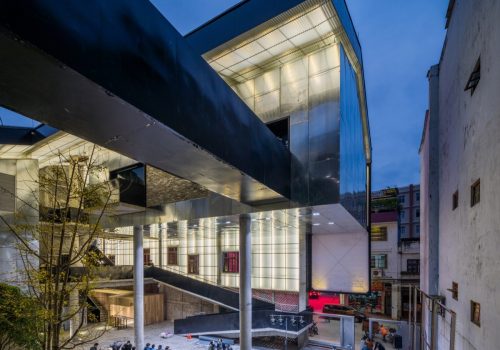China now has its first photography museum supported by public structures. Private museums and foundations open continuously in China, and they are linked to the economic success of certain entrepreneurs for whom, following the model of some major Western patrons of the industry, investing in art is a strategy of image and power. The difference here must be emphasized.
It is in Lianzhou, a small city of 600,000 inhabitants surrounded by mountains, where, in a former candy factory, this beautiful tool has opened as the logical continuation of the festival, created by Duan Yuting in 2005. This determined small woman with a very clear agenda has collaborated with François Cheval, former director of the Musée Nicéphore Niepce in Chalon-sur-Saône. However, it was she who succeeded in convincing the authorities of the interest of this new space that will allow an annual program in three steps.
In a country that is quick to demolish old buildings, the renovation work done by the cabinet “O-office Architects”, a young group based in Guangzhou, is really remarkable. Respect of the structure, of the neighborhood in the old city, concern for balance, beautiful perspectives, harmonious spaces, fluid and complex circulation are all evident. All of it makes you want to lose yourself from one level to the next. between old concrete and the reuse of tile on the façade, some sprucing up with big patches of stainless steel, and a reasonable extension that does not rise above the surrounding buildings. It offers an outdoor auditorium where the first awards ceremony swimmingly kicked off with a remarkable concert by the group Wu Tiao Ren against the backdrop of an amazing, grainy, black and white video that went along flawlessly with the accordion and guitar.
One could carry on with the relevance of this addition, with reasonable exhibition space . where it is really possible to conceive good exhibitions and to generously welcome the public, who will feel rather confortable in the large courtyard, where a tree was kept . From there, one can directly access the only spot in the city where one is able to have an excellent coffee, accompanied by very good cheesecake.
It is a compelling museum of which many Western cities could dream of. As for the program, we will kindly wait to see what the months to come will offer. The opening proposal is, at the very least, disarming since it is difficult to connect the intentions of the four artists presented and to really understand why they are there at the same time. Young French artist Baptiste Rabichon’s work of great quality, brilliantly exploring the possible combinations between digital and analog, seems to affirm that the museum will defend sharp and international contemporary creation. Is it accessible enough for a start?
It is better than giving an artist’s status to Albert Watson, an excellent and efficient professional jack-of-all-trades, from celebrity to advertising, to fashion and beauty as soon as financial stakes are substantial . He imposed upon us a projection of the five hundred pages from his fat book in which he shows as personal work bad landscapes that are the product of a commission for a Scottish whiskey brochure. The fact that he had taken some photos in China about forty years ago– and the fact that showing these images of China before their choice of a capitalistic system displease the authorities– is not sufficient to celebrate him as much, since these square, black and while snapshots, some of which show a dialogue with the propaganda photo of the time, hanging with more recent images, are photoshopped to a great extent. There is also the monkey series of which Watson is proud to the extent that he explains– one must wonder if he realizes what he is saying– that the animal spent a wonderful day copying– we do not dare write aping– the gestures and postures of the photographer.
To remain in balance, two Chinese artists are prominently shown. Zhang Hai’er and his sad “Girls” in black and white, with some prints that are probably too big, create a very beautiful series which questions eroticism, appearance, disguise, and codes. As for Zhuang Hui, the most widely shown (being in three rooms), he is undoubtably very interesting, even if one could be less responsive to his works of mountains, preferring his older series, a magnificent group panorama, an amusing series of self-portraits with artists and others, baths for men and women that are sometimes embellished with bits of black duct tape to draw attention to genitalia ,which were very out of focus, and a very constructed series of installations in the desert.
Lianzhou is giving China its first museum of photography. It is excellent news, since it is about a magnificent tool. Waiting for the coming program and establishing a public is the real challenge.
Christian Caujolle
Today an independent curator, Christian Caujolle was the director of photographie for the newspaper Libération, created the VU’ agency and gallery, and teaches at the École Nationale Supérieure Louis Lumière in Paris. He is also the artistic director of the Photo Phnom Penh festival.
Lianzhou Foto / Lianzhou Museum of Photography
No.14 Tuanjie Rd., Overseas Chinese New Town,
Yuexiu district, Guangzhou, P. C. 510095
China
















